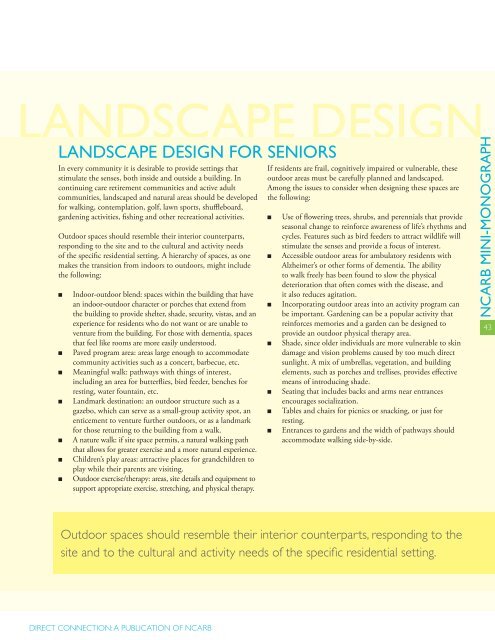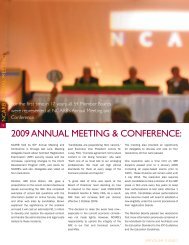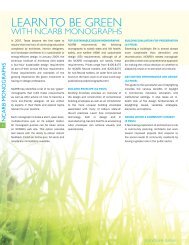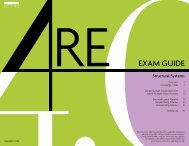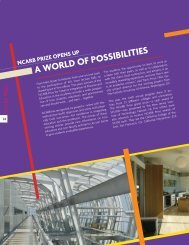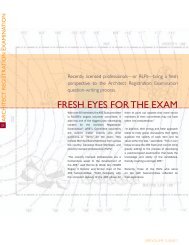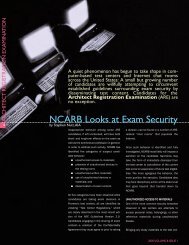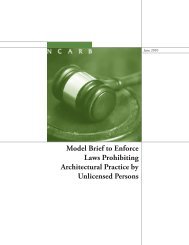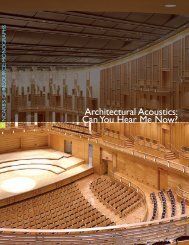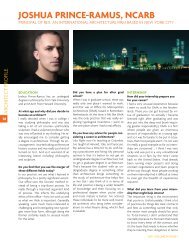FOR SENIORS - NCARB
FOR SENIORS - NCARB
FOR SENIORS - NCARB
Create successful ePaper yourself
Turn your PDF publications into a flip-book with our unique Google optimized e-Paper software.
LANDSCAPE DESIGN<br />
LANDSCAPE DESIGN <strong>FOR</strong> <strong>SENIORS</strong><br />
In every community it is desirable to provide settings that<br />
stimulate the senses, both inside and outside a building. In<br />
continuing care retirement communities and active adult<br />
communities, landscaped and natural areas should be developed<br />
for walking, contemplation, golf, lawn sports, shuffleboard,<br />
gardening activities, fishing and other recreational activities.<br />
Outdoor spaces should resemble their interior counterparts,<br />
responding to the site and to the cultural and activity needs<br />
of the specific residential setting. A hierarchy of spaces, as one<br />
makes the transition from indoors to outdoors, might include<br />
the following:<br />
n Indoor-outdoor blend: spaces within the building that have<br />
an indoor-outdoor character or porches that extend from<br />
the building to provide shelter, shade, security, vistas, and an<br />
experience for residents who do not want or are unable to<br />
venture from the building. For those with dementia, spaces<br />
that feel like rooms are more easily understood.<br />
n Paved program area: areas large enough to accommodate<br />
community activities such as a concert, barbecue, etc.<br />
n Meaningful walk: pathways with things of interest,<br />
including an area for butterflies, bird feeder, benches for<br />
resting, water fountain, etc.<br />
n Landmark destination: an outdoor structure such as a<br />
gazebo, which can serve as a small-group activity spot, an<br />
enticement to venture further outdoors, or as a landmark<br />
for those returning to the building from a walk.<br />
n A nature walk: if site space permits, a natural walking path<br />
that allows for greater exercise and a more natural experience.<br />
n Children’s play areas: attractive places for grandchildren to<br />
play while their parents are visiting.<br />
n Outdoor exercise/therapy: areas, site details and equipment to<br />
support appropriate exercise, stretching, and physical therapy.<br />
DIRECT CONNECTION: A PUBLICATION OF <strong>NCARB</strong><br />
If residents are frail, cognitively impaired or vulnerable, these<br />
outdoor areas must be carefully planned and landscaped.<br />
Among the issues to consider when designing these spaces are<br />
the following:<br />
n Use of flowering trees, shrubs, and perennials that provide<br />
seasonal change to reinforce awareness of life’s rhythms and<br />
cycles. Features such as bird feeders to attract wildlife will<br />
stimulate the senses and provide a focus of interest.<br />
n Accessible outdoor areas for ambulatory residents with<br />
Alzheimer’s or other forms of dementia. The ability<br />
to walk freely has been found to slow the physical<br />
deterioration that often comes with the disease, and<br />
it also reduces agitation.<br />
n Incorporating outdoor areas into an activity program can<br />
be important. Gardening can be a popular activity that<br />
reinforces memories and a garden can be designed to<br />
provide an outdoor physical therapy area.<br />
n Shade, since older individuals are more vulnerable to skin<br />
damage and vision problems caused by too much direct<br />
sunlight. A mix of umbrellas, vegetation, and building<br />
elements, such as porches and trellises, provides effective<br />
means of introducing shade.<br />
n Seating that includes backs and arms near entrances<br />
encourages socialization.<br />
n Tables and chairs for picnics or snacking, or just for<br />
resting.<br />
n Entrances to gardens and the width of pathways should<br />
accommodate walking side-by-side.<br />
Outdoor spaces should resemble their interior counterparts, responding to the<br />
site and to the cultural and activity needs of the specific residential setting.<br />
<strong>NCARB</strong> MINI-MONOGRAPH<br />
MINI-MONOGRAPH<br />
43


